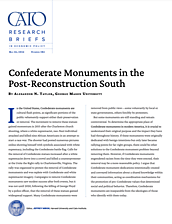In the United States, Confederate monuments are cultural flash points, as significant portions of the public vehemently support either their preservation or removal. The movement to remove these statues gained momentum in 2015 after the Charleston church shooting, where a white supremacist, neo-Nazi individual attacked and killed nine African Americans in an attempt to start a race war. The shooter had posted numerous pictures online showing himself with symbols associated with white supremacy, including the Confederate battle flag. Calls for the removal of Confederate statues increased after a white supremacist drove into a crowd and killed a counterprotester at the Unite the Right rally in Charlottesville, Virginia. The rally was organized to protest the removal of Confederate monuments and was replete with Confederate and white supremacist imagery. Campaigns to remove Confederate monuments saw modest success after both events, but it was not until 2020, following the killing of George Floyd by a police officer, that the removal of these statues gained widespread support. Many Confederate monuments were removed from public view—some voluntarily by local or state governments, others forcibly by protesters.
But some monuments are still standing and remain controversial. To determine the appropriate place of Confederate monuments in modern America, it is crucial to understand their original purpose and the impact they have had throughout history. If these monuments were originally dedicated with benign intentions but only later became rallying points for far-right groups, there could be other solutions to the Confederate monument problem beyond removing them. However, if Confederate monuments engendered racism from the time they were erected, their removal may be a more reasonable policy. I argue that Confederate monument dedications intentionally created and conveyed information about a shared knowledge within their communities, acting as coordination mechanisms for the promotion of pro-Confederate values that determined social and political behavior. Therefore, Confederate monuments are inseparable from the ideologies of those who identify with them today.
My research assesses this claim by investigating the impact of Confederate monument dedications on political and social behavior in the American South in the late 19th and early 20th centuries. It uses data on monument dedications, vote shares for the Democratic Party (which during this era sought to impose racial segregation across the South), voter turnout rates, African American demographics, and violence against African Americans at the county level from 1878 to 1912. The results indicate that Southern counties that dedicated Confederate monuments during this period saw an increase of 4–6 percentage points in Democratic Party vote shares, a decrease of 1–3 percentage points in voter turnout rates, and a decline of approximately 1 percentage point in their African American populations relative to counties that did not dedicate monuments. However, my research finds no evidence that Confederate monuments increased violence against African Americans. These effects emerged slowly and took one or two elections to fully manifest, suggesting that when communities build monuments, they do so to drive social change and influence the public to embrace a new set of values rather than convey values that are already widely accepted.
Furthermore, my research finds that the impact of Confederate monuments on voter turnout varies based on the characteristics of the monuments. My findings suggest that monuments dedicated to important Confederate figures like Robert E. Lee and Stonewall Jackson, as well as other individuals honored by two or more monuments between 1878 and 1912, increased voter turnout by 13.6 percentage points. Monuments sponsored by women’s and veteran children’s organizations increased turnout by 6.4 and 8.0 percentage points, respectively. Monuments on government grounds, however, decreased voter turnout by 5 percentage points.
What are the implications for assessing Confederate monuments and the ongoing debates over their removal? My research reveals that these monuments fostered pro-Confederate political behavior and belief in the Lost Cause—a pseudohistorical myth that portrays the Confederacy as just and heroic—in the post-Reconstruction South. Previous studies have also shown that monuments dedicated in subsequent periods were done so expressly for discriminatory reasons. Still, some debate whether this matters today. To answer this question, it is important to consider the historical purpose and impact of monument dedications, the modern purpose and impact of preserving these monuments, and the effectiveness of removing them.
If monuments and other Confederate symbols were to simply fade into the background of public life and lose their meaning, removing them today would probably have little effect. However, previous research has shown that cultural symbols retain their meaning over time. The mere fact that there are ongoing debates regarding Confederate monuments today is evidence that they still hold significance to large swaths of the American population. Other studies have demonstrated the modern effects of these symbols, and future work should further examine their impact and explore the implications they carry. Nevertheless, the fact that there is continued controversy shows that Confederate monuments are as significant as ever. Their present meaning for many people is not detached from their historical purpose, which was to promote the Lost Cause myth and a society built on racial discrimination.
Note:
This research brief is based on Alexander N. Taylor, “Monumental Effects: Confederate Monuments in the Post-Reconstruction South,” George Mason University Working Paper in Economics no. 23–44, July 2023.

This work is licensed under a Creative Commons Attribution-NonCommercial-ShareAlike 4.0 International License.
